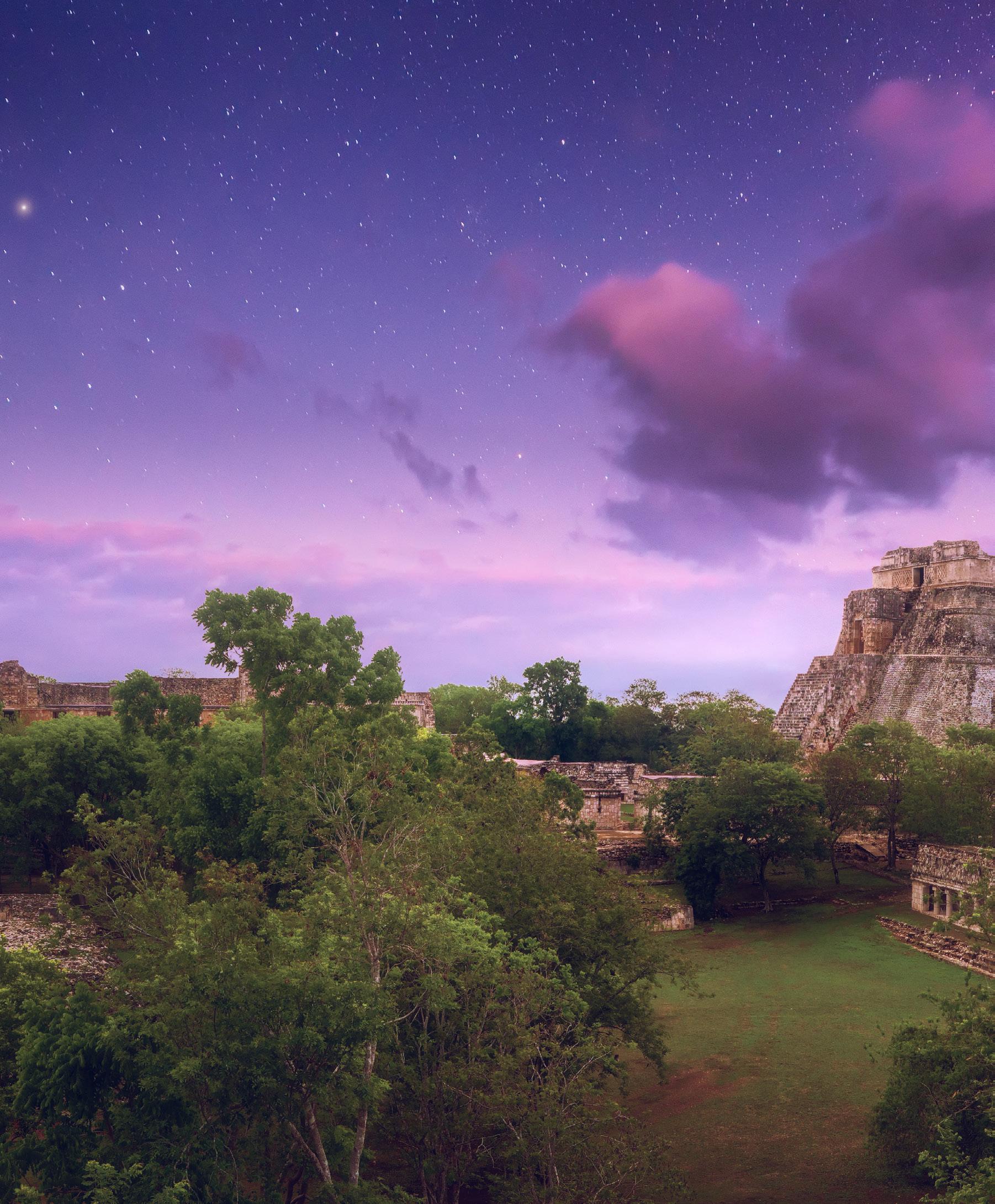
15 minute read
Gateway to a world
Venture beyond the beach into the Yucatan and start exploring the Maya World where endless experiences await you as Joanna Green discovers
LA PUERTA A UN MUNDO AVENTÚRESE MÁS ALLÁ DE LAS PLAYAS VIAJANDO HACIA YUCATÁN Y EMPIECE A EXPLORAR EL MUNDO MAYA, DONDE LE ESPERA UN SINFÍN DE EXPERIENCIAS, COMO LO DESCUBRE JOANNA GREEN
Advertisement
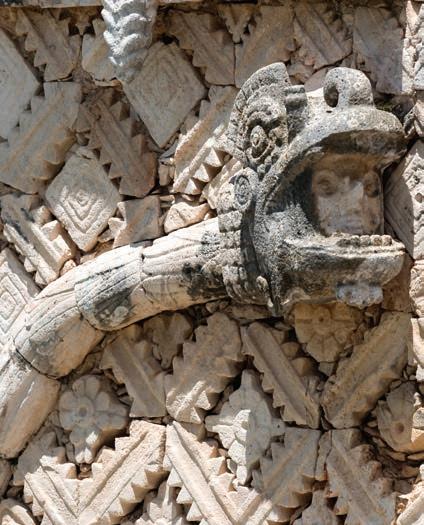
SHUTTERSTOCK
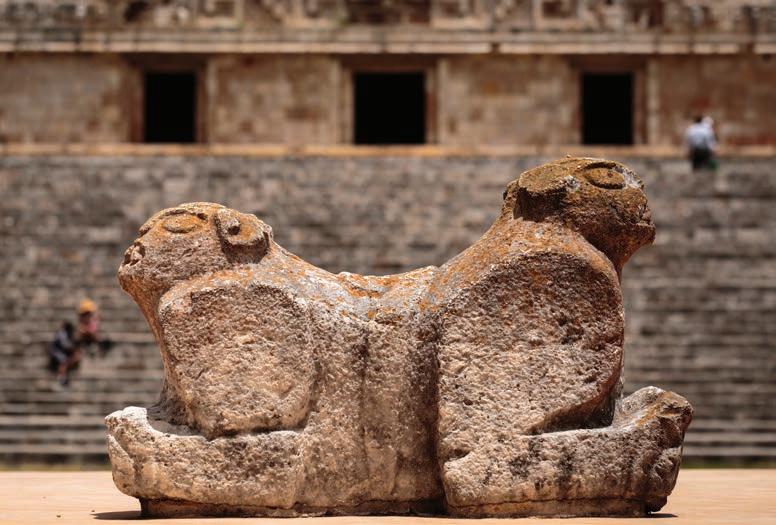
This page, the view of the Pyramid of the Magician from the Palace of the Governor, Uxmal. Top right, a jaguar throne and serpent, both held sacred by the ancient Maya, Uxmal
Esta página, la vista de la Pirámide del Adivino desde el Palacio del Gobernador, Uxmal. Arriba a la derecha, un trono de jaguar y serpiente, ambos considerados sagrados por los antiguos mayas, Uxmal
SHUTTERSTOCK
I CLIMB TO THE TOP OF THE HILL IN UXMAL crowned by the Palacio del Gobernador and gaze at the richly carved frieze of masks and snakes and the temples spread out below in southern Yucatán’s World Heritage Site. Swallows dip under the stone doorways to feed their nestlings in ancient vaults where kings once resided. The sigh of the breeze is the only sound and I have the sensation of embarking on a journey into the past. This feeling of mystery and awe is something I have felt in every Maya city that I have visited over the years. These masterpieces of art and architecture head the list of marvels to be seen in the Maya World, but this region of southeast Mexico is also rich in natural wonders, colonial churches, palaces and fortresses and the vibrant communities of today’s Maya, the proud keepers of timeless traditions. The Mexican Caribbean is the gateway to this world, accessible by air and road and eventually by rail as the Maya Train project takes shape.
Thousands of archaeological sites dot the landscape and while most still lie under a mantle of jungle awaiting exploration, those that have been restored are truly awe-inspiring. They are the legacy of one of the most advanced civilizations ever to flourish in the Americas. Temple builders, seafarers, gifted artists, stargazers, mathematicians and scribes, the ancient Maya forged a network of city-states throughout southeastern Mexico, Guatemala, Belize, western Honduras and El Salvador that reached its peak between AD 200 and 900.
Mysteries of the Mayab
Heralded as a masterpiece of architecture by Frank Lloyd Wright, Uxmal is the gateway to the Puuc Route, a chain of ancient cities that share its World Heritage listing, and distinctive artistic style characterized by ornate friezes and masks depicting the rain god Chaac. The Pyramid of the Magician dominates the skyline and the richly carved facades of the palaces in the Nun’s Quadrangle are one of the Maya World’s treasures. From Uxmal it’s a short drive to the smaller Puuc sites: Kabah, Sayil, Xlapak and Labna, to Loltun Caves, old henequen
SUBO A LA CIMA DEL CERRO EN UXMAL, coronado por el Palacio del Gobernador y admiro frisos ricamente tallados de máscaras y serpientes y los templos que se extienden abajo en el Sitio Patrimonio de la Humanidad al sur de Yucatán. El suspiro de la brisa es el único sonido y tengo la sensación de que me estoy embarcando en un viaje al pasado. Este sentimiento de misterio y asombro es algo que he apreciado en cada ciudad maya que he visitado a través de los años. Estas obras maestras de arte y arquitectura encabezan la lista de maravillas para ser admiradas en el Mundo Maya, aunque esta región del sureste de México también es rica en maravillas naturales, iglesias coloniales, palacios y fortalezas y las vibrantes comunidades de los mayas actuales, los orgullosos custodios de tradiciones ancestrales. El Caribe mexicano es la puerta de entrada a este mundo, accesible por tierra y aire y próximamente por tren, cuando el proyecto del Tren Maya tome forma.
Miles de sitios arqueológicos salpican el paisaje y aunque la mayoría aún permanecen bajo un manto de selva esperando ser explorados, aquellos que han sido restaurados son
haciendas and a chain of historic Maya villages with colonial churches known as the Convent Route.
Whenever I want to explore Yucatán, I head for Mérida, the state capital. Founded by the Spanish conquistador Francisco de Montejo in 1542 on the site of an earlier Maya city called T’ho, it is steeped in history and tradition. Once you have spent several days strolling through the colonial heart visiting churches, museums and mansions, it is the perfect base for exploring the surrounding area. To the east lie the twin colonial towns of Valladolid and Izamal, site of a bright yellow convent built on top of a Maya pyramid. There are more ancient Maya cities like world-famous Chichén Itzá, also a World Heritage Site, and Ek Balam. The landscape is peppered with cenotes (sinkholes) and caves. Ría Lagartos, the Gulf coast Biosphere Reserve is home to thousands of flamingos. On the west coast of the Yucatán Peninsula is Celestún Biosphere Reserve and between them both lie miles and miles of shell-strewn shoreline and scattered fishing communities.
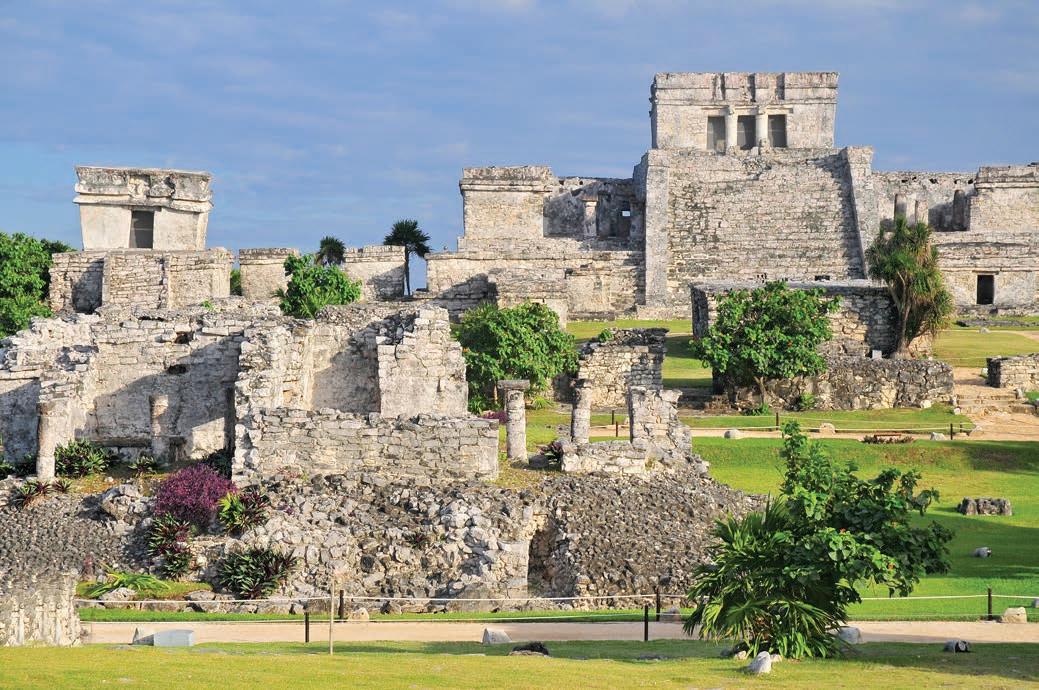
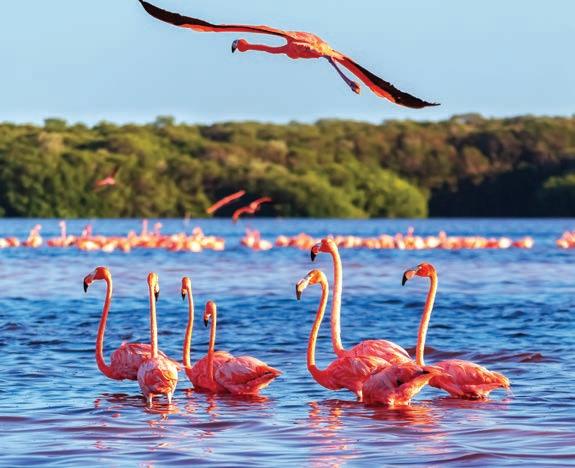
Between the jungle and the sea
From the pyramids and ball courts deep in the jungle at Cobá to clifftop temples at Tulum on the Riviera Maya coast, Quintana Roo is full of Maya sites. In the south, the land once sustained more than a million inhabitants in cities like Kohunlich and Dzibanche and there is evidence of ancient irrigation and terrace farming.
A visit to Quintana Roo’s archaeological sites is an opportunity to learn about history and be at one with nature. In Coba, I follow a shimmering blue butterfly to a cluster of buildings under a tangle of jungle creepers and tree roots. In Sian Ka’an Biosphere Reserve, a canal through the mangroves dredged by Maya traders more than a thousand years ago leads to a tiny temple and then on to the Caribbean coast. I marvel at those intrepid traders who braved coral reefs and tempests to bring feathers, gold and jade from Central America and carry them overland to cities in the Yucatán.
Beyond the glorious beaches of Quintana Roo, nature beckons. The magnificent coral kingdom of the Mesoamerican Reef and the islands of Cozumel, Isla Mujeres, Contoy and Holbox lie offshore. In the Riviera Maya, an incredible secret world is hidden deep in the limestone, a network of cenotes and flooded caves where divers have discovered the longest underground rivers on the planet and the remains of nomadic hunter gatherers and prehistoric animals more than 12,000 years old. Bacalar Lagoon is a vision in turquoise and a patchwork of biosphere reserves protects the state’s jungles and wetlands where jaguars still roam, and birds take to the air in a splash of color.
In the center of the state, Maya villages are guardians of ancient traditions and are ready to share them with visitors through Maya Ka’an community tours.
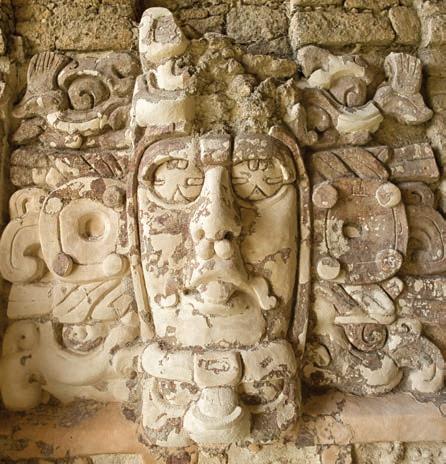
Ancient kings and pirate tales
A brilliant sunset over the Gulf of Mexico ends a day of exploring colonial churches and forts in the historic port
SHUTTERSTOCK
SHUTTERSTOCK SHUTTERSTOCK
realmente asombrosos. Son el legado de una de las civilizaciones más avanzadas que florecieron en las Américas. Los antiguos mayas forjaron una red de ciudades estado en el sureste de México, Guatemala, Belice, el oeste de Honduras y El Salvador, que alcanzaron su auge entre el 200 y 900 d.C.
Misterios del Mayab
Uxmal es el umbral a la Ruta Puuc, una cadena de antiguas ciudades que comparten el honor de ser Patrimonio de la Humanidad, y un estilo artístico distintivo caracterizado por frisos y máscaras representando al dios de la lluvia Chaac. La Pirámide del Adivino domina el paisaje y el Cuadrángulo de las Monjas es otro de los tesoros del Mundo Maya. Desde Uxmal se llega a los sitios Puuc más pequeños: Kabah, Sayil, Xlapak y Labná, a las Grutas de Loltún y una cadena de pueblos históricos mayas con iglesias coloniales conocidos como la Ruta de los Conventos.
Cuando quiero explorar Yucatán, me dirijo a Mérida, la capital del estado. Fundada por el conquistador español Francisco de Montejo en 1542, entre las ruinas de una ciudad maya anterior llamada T’ho, está llena de historia y tradición. Una vez que haya disfrutado algunos días en el corazón colonial visitando iglesias, museos y mansiones, es la base perfecta para explorar los alrededores. Al este se encuentran los pueblos coloniales gemelos de Valladolid e Izamal, donde se encuentra un convento pintado de amarillo brillante, construido sobre una pirámide maya. Hay más ciudades mayas antiguas como la mundialmente famosa Chichén Itzá, que también es Patrimonio de la Humanidad, y Ek Balam. El paisaje está salpicado de cenotes y cuevas. Río Lagartos y Celestún, las Reservas de la Biósfera en la costa del Golfo, albergan miles de flamencos y entre ambas, hay kilómetros y kilómetros de costa y comunidades pesqueras dispersas.
of Campeche, a UNESCO World Heritage Site. During the late 17th century, walls and ramparts were built to protect this settlement from the pirates who preyed on galleons laden with the prized palo de tinte or logwood, which yielded a rich brown dye. Several of these forts are now museums and the largest, San Miguel, also displays Campeche’s extraordinary Maya treasures, including jade death masks from Calakmul and clay figurines from the island of Jaina.
From the tiered temples at Edzná to mighty Calakmul in the south, the Maya left their imprint on the landscape. One of the largest archaeological sites in the Maya World, Calakmul was a regional power between 250 BC and AD 700. More than 6,000 buildings have been found to date, along with funerary offerings of jade and ceramics and 120 stelae telling a story of the ruling dynasty, its alliances and military conquests. Calakmul is a World Heritage Site and the Biosphere Reserve that shares its name forms part of the second largest jungle reserve in the Americas, home to howler and spider monkeys, king vulture and tapir.
Go further afield
Venturing further into southeast Mexico will take you to the state of Tabasco on the Gulf coast. In ancient times, the fertile lowlands traversed by mighty rivers were inhabited by two cultures, the Olmec and the Maya.
Top, A beacon and port for Maya seafarers, Tulum on the Quintana Roo coast. Sun god mask, Kohunlich, flamingos inhabit Río Lagartos and Celestún (shown here), Izamal, Yucatan. Right, nature and history in Calakmul, Campeche
SHUTTERSTOCK Arriba, un puerto para los navegantes mayas, Tulum en la costa de Quintana Roo. Mascarón del dios del sol, Kohunlich, flamencos habitan Río Lagartos y Celestún (mostrado aquí), Izamal, Yucatán. Derecha, naturaleza e historia en Calakmul, Campeche

Entre la selva y el mar
Quintana Roo está lleno de sitios mayas, desde las pirámides en lo profundo de la selva en Cobá hasta los templos en el acantilado de Tulum, en la Riviera Maya. En el sur, el territorio albergó alguna vez a más de un millón de habitantes en ciudades como Kohunlich y Dzibanché.
Una visita a los sitios arqueológicos de Quintana Roo es una oportunidad para aprender acerca de su historia y unirse con la naturaleza. En Cobá, sigo a una reluciente mariposa azul hasta un grupo de edificios bajo una maraña de enredaderas y raíces de árboles. En la Reserva de la Biósfera de Sian Ka’an, un canal a través de los manglares dragados por los comerciantes mayas hace más de mil años, conduce a un pequeño templo y luego hasta la costa del Caribe.
Más allá de las gloriosas playas de Quintana Roo, la naturaleza llama. El maravilloso reino de coral del Arrecife Mesoamericano y las islas de Cozumel, Isla Mujeres, Contoy y Holbox se encuentran frente a la costa. En la Riviera Maya, un increíble mundo secreto está oculto en la roca caliza, una red de cenotes y cuevas inundadas donde los buzos han descubierto los ríos subterráneos más largos del planeta y los restos de habitantes y animales prehistóricos de más de 12,000 años de antigüedad. La Laguna de Bacalar es una visión turquesa y un mosaico de reservas de la biósfera protege las selvas y humedales del estado donde los jaguares todavía deambulan, y las aves vuelan con un toque de color.
En el centro del estado, los pueblos mayas son guardianes de antiguas tradiciones y están dispuestos a compartirlas con los visitantes a través de los paseos comunitarios de Maya Ka’an.
Relatos antiguos de reyes y piratas
Un brillante atardecer sobre el Golfo de México pone fin a un día de exploración
SHUTTERSTOCK
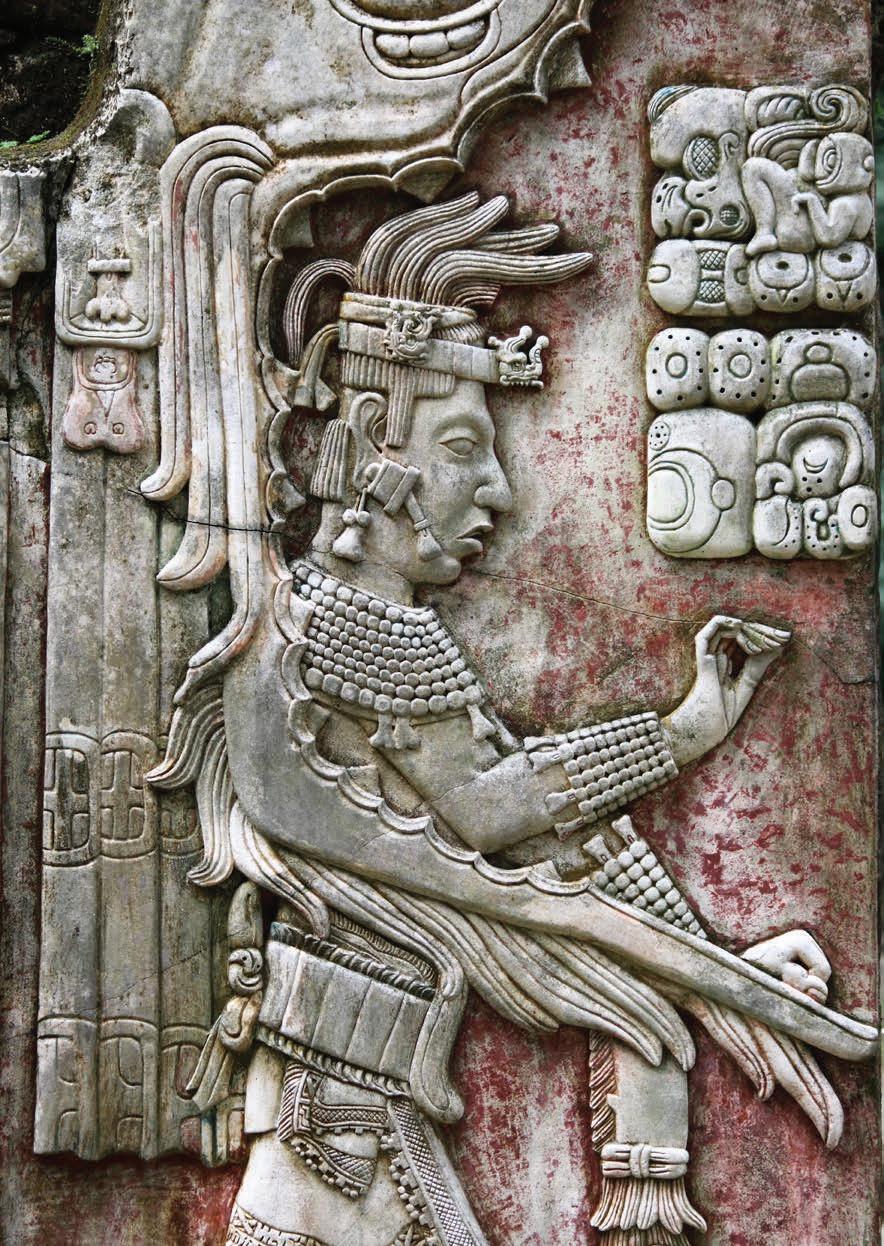
On the outskirts of the capital Villahermosa lies La Venta Park, an open-air museum displaying the massive stone heads and sculptures that are the legacy of the Olmecs. Centuries later, the Maya settled in the area and archaeological sites such as Pomoná, Reforma and Comalcalco, a unique city built with fired clay bricks are testimony to their presence.
Tropical rain forest that is a bastion for howler monkeys, macaws and the harpy eagle gives way to mist-shrouded mountains and pine forests, Chiapas is a mosaic of landscapes, a tapestry of Maya traditions. The white citadel of Palenque ruled by the all-powerful Pakal between AD 615 and 683 heads the list of Maya sites to visit, but Yaxchilan and Bonampak in the Lacandón jungle and enigimatic Toniná are also unforgettable travel adventures.
The winding road from Palenque leads up through the hills to the colonial city of San Cristóbal de las Casas. Founded in 1528 by Diego de Mazariegos and full of bustling markets and grand old churches like Santo Domingo, San Cristobal lies at the heart of the Maya highlands. In Tzotzil and Tzeltal Maya villages, people keep faith with the old ways, wearing traditional garb. Clusters of painted wooden crosses mark sacred spots and priests burn incense and make offerings in rituals that are a syncretism of Christianity and older beliefs.
Start exploring the world of wonders beyond the beach.
Contact the Thomas More Travel desk at your resort, call ext. 175 or 407 or go to www.thomasmoretravel.com for tours in Yucatan and Quintana Roo and the Maya World.
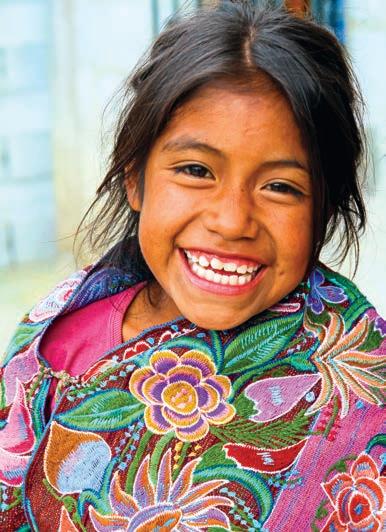
de iglesias coloniales y fuertes en el histórico puerto de Campeche, Patrimonio de la Humanidad. A finales del Siglo XVII, se construyeron murallas y baluartes para proteger este asentamiento de los piratas que asaltaban los galeones cargados del palo de tinte, una madera preciada por el color que daba a los tintes. Varios de estos fuertes ahora son museos y el más grande, San Miguel, exhibe los extraordinarios tesoros mayas de Campeche, incluyendo máscaras de jade de Calakmul y figuritas de barro de Jaina.
Desde los templos escalonados de Edzná hasta la poderosa Calakmul, los mayas dejaron su huella en el paisaje. Calakmul, uno de los sitios arqueológicos más grandes del Mundo Maya, fue un poderío regional entre el 250 a.C. y el 700 d.C. A la fecha han sido encontrados más de 6,000 edificios y 120 estelas que cuentan una historia de la dinastía gobernante, sus alianzas y conquistas militares. Calakmul es Patrimonio de la Humanidad y la reserva de la biósfera que comparte su nombre forma parte de la segunda reserva de selva más grande de América.
Ir más lejos
Adentrarse más en el sureste de México lo llevará al estado de Tabasco, en la costa del Golfo. En la antigüedad, las fértiles tierras bajas atravesadas por caudalosos ríos estuvieron habitadas por dos culturas, la olmeca y la maya.
En las afueras de Villahermosa, la capital, se encuentra el Parque Museo La Venta y las enormes cabezas de piedra y esculturas que son el legado de los olmecas. Siglos después, los mayas se asentaron en el área y evidencia de su ocupación puede ser hallada en los sitios arqueológicos como Pomoná, Reforma y Comalcalco, una ciudad singular construida con ladrillos de barro cocido.
La selva, que es la tierra de monos aulladores, guacamayas y el águila harpía, da paso a montañas cubiertas de niebla y bosques de pinos, Chiapas es un mosaico de paisajes y de tradiciones mayas. La ciudad blanca de Palenque gobernada por el todo poderoso Pakal entre 615 y 683 d.C., encabeza la lista, aunque Yaxchilán y Bonampak, en la selva Lacandona, y la enigmática Toniná, son aventuras de viaje inolvidables.
El sinuoso camino de Palenque conduce a través de las montañas hasta la ciudad colonial de San Cristóbal de las Casas. Fundada en 1528 por Diego de Mazariegos y llena de mercados bulliciosos e iglesias antiguas como Santo Domingo, San Cristóbal se encuentra en el corazón de las tierras altas mayas. En los pueblos mayas Tzotzil y Tzeltal, los pobladores mantienen las viejas costumbres, vistiendo los atuendos tradicionales. Grupos de cruces de madera pintadas señalan los lugares sagrados en el mundo natural y en la iglesia de San Juan Chamula, los sacerdotes queman incienso y hacen ofrendas en rituales que son un sincretismo del cristianismo y creencias más antiguas.
Comience a explorar el mundo de maravillas más allá de la playa.
Left, a member of the ruling dynasty of Palenque. Right, a girl from Zinacantán, the mountains of Chiapas are dotted with Tzotzil and Tzeltal Maya villages, keepers of timeless traditions
Izquierda, miembro de la dinastía gobernante de Palenque. Derecha, una niña de Zinacantán, los pueblos mayas Tzotzil y Tzeltal de las montañas de Chiapas mantienen las tradiciones ancestrales
Contacte a la agencia de viajes Thomas More Travel en su resort llamando a la ext. 175 ó 407 o visite la página www.thomasmoretravel.com para paseos en Yucatán y Quintana Roo y en el Mundo Maya.










